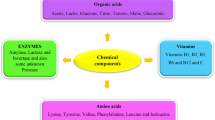Abstract
Steviol glucosides (SGs) such as rubusoside (Ru), stevioside (Ste), rebaudioside A (RebA) and stevioside glucosides (SG) are herbal tea sweeteners that enhance the solubility and stability of a number of pharmaceutically important compounds. The complex of epigallocatechin gallate (EGCG) with 10% (w/v) each Ru, Ste, RebA or SG enhanced the water solubility of EGCG over 15 times to 345, 312, 341, or 320 mg/mL, respectively. The 2,2-diphenyl-1-picrylhydrazyl radical scavenging (SC50) activities of EGCG, EGCG-Ru, EGCG-Ste, EGCG-RebA, and EGCG-SG in water were 5.88, 6.03, 6.52, 4.89, and 4.23 μg/mL, respectively. EGCGs complexed with different SGs maintained inhibitory activities against human intestinal maltase, human pancreatic α-amylase, and the growth of Streptococcus mutans, Helicobacter pylori, Salmonella typhimurium, Listeria monocytogenes, Staphylococcus aureus, and Clostridium difficile. In glucose tolerance test using C57BL/6 mice, plasma glucose levels in mice treated with EGCG or EGCG-Ste complex were decreased by 9.34%, which was 31.08% lower than those treated with maltose. The efficient and cost-effective EGCG-SGs production method might be applicable to produce water soluble bioactive nutraceuticals in large scale.
Similar content being viewed by others
References
Zaveri, N. T. (2006) Green tea and its polyphenolic catechins: Medicinal uses in cancer and noncancer applications. Life Sci. 78: 2073–2080.
Smith, A. J., P. Kavuru, K. K. Arora, S. Kesani, J. Tan, M. J. Zaworotko, and R. D. Shytle (2013) Crystal engineering of green tea epigallocatechin-3-gallate (EGCg) cocrystals and pharmacokinetic modulation in rats. Mol. Pharm. 10: 2948–2961.
Moon, Y. H., J. H. Lee, J. S. Ahn, S. H. Nam, D. K. Oh, D. H. Park, H. J. Chung, S. Kang, D. F. Day, and D. Kim (2006) Synthesis, structure analyses, and characterization of novel epigallocatechin gallate (EGCG) glycosides using the glucansucrase from Leuconostoc mesenteroides B-1299CB. J. Agric. Food Chem. 54: 1230–1237.
Su, Y. L., L. K. Leung, Y. Huang, and Z. Y. Chen (2003) Stability of tea theaflavins and catechins. Food Chem. 83: 189–195.
Forester, S. C. and J. D. Lambert (2014) Synergistic inhibition of lung cancer cell lines by (-)-epigallocatechin-3-gallate in combination with clinically used nitrocatechol inhibitors of catechol-O-methyltransferase. Carcinogen. 35: 365–372.
Nguyen, T. T. H., S.-H. Jung, S. Lee, H.-J. Ryu, H.-K. Kang, Y.-H. Moon, Y.-M. Kim, A. Kimura, and D. Kim (2012) Inhibitory effects of epigallocatechin gallate and its glucoside on the human intestinal maltase inhibition. Biotechnol. Bioproc. Eng. 17: 966–971.
Chow, H. H. S., I. A. Hakim, D. R. Vining, J. A. Crowel, J. Ranger-Moore, W. M. Chew, C. A. Celaya, S. R. Rodney, Y. Hara, and D. S. Alberts (2005) Effects of dosing condition on the oral bioavailability of green tea catechins after single-dose administration of Polyphenon E in healthy individuals. Clin. Cancer Res. 11: 4627–4633.
Valcic, S., J. A. Burr, B. N. Timmermann, and D. C. Liebler (2000) Antioxidant chemistry of green tea catechins. New oxidation products of (-)-epigallocatechin gallate and (-)-epigallocatechin from their reactions with peroxyl radicals. Chem. Res. Toxicol. 13: 801–810.
Wang, R., W. B. Zhou, and X. H. Jiang (2008) Reaction kinetics of degradation and epimerization of epigallocatechin gallate (EGCG) in aqueous system over a wide temperature range. J. Agric. Food Chem. 56: 2694–2701.
Zhu, M., Y. Chen, and R. C. Li (2000) Oral absorption and bioavailability of tea catechins. Planta Med. 66: 444–447.
Smith, A., B. Giunta, P. C. Bickford, M. Fountain, J. Tan, and R. D. Shytle (2010) Nanolipidic particles improve the bioavailability and alpha-secretase inducing ability of epigallocatechin-3-gallate (EGCG) for the treatment of Alzheimer's disease. Int. J. Pharm. 389: 207–212.
Dube, A., J. A. Nicolazzo, and I. Larson (2011) Chitosan nanoparticles enhance the plasma exposure of (-)-epigallocatechin gallate in mice through an enhancement in intestinal stability. Eur. J. Pharm. Sci. 44: 422–426.
Nguyen, T. T., S. J. Jung, H. K. Kang, Y. M. Kim, Y. H. Moon, M. Kim, and D. Kim (2014) Production of rubusoside from stevioside by using a thermostable lactase from Thermus thermophilus and solubility enhancement of liquiritin and teniposide. Enz. Microb. Technol. 64–65: 38–43.
Kroyer, G. (2010) Stevioside and Stevia-sweetener in food: Application, stability and interaction with food ingredients. J. Verbrauch. Lebensm. 5: 225–229.
Nguyen, T. T., J. Si, C. Kang, B. Chung, D. Chung, and D. Kim (2017) Facile preparation of water soluble curcuminoids extracted from turmeric (Curcuma longa L.) powder by using steviol glucosides. Food Chem. 214: 366–373.
Lee, S. J., D. G. Lee, S. H. Park, M. Kim, C. S. Kong, Y. Y. Kim, and S. H. Lee (2015) Comparison of biological activities in Sargassum siliquanstrum fermented by isolated lactic acid bacteria. Biotechnol. Bioproc. Eng. 20: 341–348.
Charoensapyanan, R., P. Rudeekulthamrong, and J. Kaulpiboon (2016) Enzymatic synthesis of propyl-alpha-glycosidases ad their application as emulsifying and antibacterial agents. Biotechnol. Bioproc. Eng. 21: 389–401.
Zhang, X., J. Wang, J. M. Hu, Y. W. Huang, X. Y. Wu, C. T. Zi, X. J. Wang, and J. Sheng (2016) Synthesis and biological testing of novel glucosylated epigallocatechin gallate (EGCG) derivatives. Molecules 21: E620.
Gamboa, F. and M. Chaves (2012) Antimicrobial potential of extracts from Stevia rebaudiana leaves against bacteria of importance in dental caries. Acta Odontol. Latinoam. 25: 171–175.
Author information
Authors and Affiliations
Corresponding author
Rights and permissions
About this article
Cite this article
Nguyen, T.T.H., Kim, N.M., Yeom, SC. et al. Biological characterization of epigallocatechin gallate complex with different steviol glucosides. Biotechnol Bioproc E 22, 512–517 (2017). https://doi.org/10.1007/s12257-017-0286-x
Received:
Revised:
Accepted:
Published:
Issue Date:
DOI: https://doi.org/10.1007/s12257-017-0286-x




